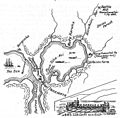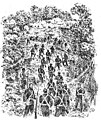Wellington and Wanganui (1846-47)
| [▲]The New Zealand Wars | ||
|---|---|---|
| Wellington and Wanganui (1846-47) | Boulcott's Farm | Pauatahanui | Horokiwi/Battle Hill | Gilfillan's Farm | St. John's Wood | |
Contents
[hide]Wellington (1846)
Largely encouraged by the New Zealand Company's improper land deals, settlers began encroaching onto traditional Maori land through the 1840s. The escalating aggression between Maori and European settlers cam to a head with the killing of the Andrew Gillespie and his son at Boulcott's farm. The conflicts were unresolved at the end of 1846 with no clear victor evident. Again, Europeans lacked the resources to mount an effective campaign and spent several months being led through the New Zealand bush in a series of fruitless exercises.
Boulcott's Farm (2nd April 1846)
On the 2nd of April 1846, Andrew Gillespie and his son were killed by Ngati Rangatahi while working their land. Shortly after, on the 16th of May, a stockade on Almon Boulcott's farm was attacked and eight pakeha were killed. The site of the battle is now a golf course.
"A volley was delivered from fifty Maori guns. The Maoris fired low, to rake the floor of the tents. A second volley; another from a different flank; then on came the enemy with the tomahawk. Not a soldier of the picket escaped. Those who were not killed by the volley fell to the short-handled patiti. In and about the picket tent four soldiers lay dead. One of these was William Allen, whose name will be remembered so long as the story of Boulcott's Farm is told. Allen was a tall, young soldier; he was bugler to his company. When the sentry's shot was heard he leaped up, seized his bugle, and, running outside the tent, he put the bugle to his lips to blow the alarm. In the act of sounding the call he was attacked by a Maori, who tomahawked him in the right shoulder, nearly severing his arm, and felled him to the ground. Struggling to rise, the brave lad seized the bugle with his left hand and again attempted to warn his comrades, but a second blow with the tomahawk, this time in the head, killed him. The bugler's call was not needed, however, for the whole camp had been awakened by the sentry's shot and the answering volleys."[1]
Mataitaua, Pauatahanui (1st August 1846)
St Alban's church is built on the remains of Te Rangihaeata's pa Mataitaua nearParemata harbour. Sailors in small boats during July 1946 sometimes skirmished with local Maori, before a full assault was launched on the pa on 1st August 1846. Rangihaeata retreated to Horokiri without offering any resistance.
Horokiri/Battle Hill (6th-10th August 1846)
This formidable ridge-top pa, complete with trenches was the Te Rangihaeata's new position after abandoning Mataitaua. Several attacks were made, none of which were successful, although the Europeans lost several men. Three days after the first assault, the position was again found to be abandoned. Horokiri was another frustrating and expensive waste of time.
Whanganui (1847)
The Whanganui settlement was established after it was realised there wasn't enough land in Wellington to satisfy the New Zealand Company's promises, so land was always going to be an issue here. Many dubious deals were signed and settlers began moving onto Maori land. Wanganui Maori were closely aligned to Te Rangihaeata in Wellington, and these events arose partly out of anger over Grey's actions of a few months before. The conflict is typified by an escalation in skirmishes, leading to the solitary significant engagement of St. John's Wood.
Gilfillan Farm (16th April 1847)
On the 16th April 1847, the pistol of a European naval officer accidentally fired, wounding a Putiki Maori. Apparently in retaliation, six young Maori arrived at the outlying farm of the Gilfillan family on 18th April. The father, John Gilfillan, went for help, thinking his attackers would not harm a woman and her children. They were killed, however, and the house was burnt down.
St John's Wood (20th July 1847)
Skirmishing had been occurring for the previous two months, but on this occasion, European troops chased Te Mamaku's warriors into an ambush. Fighting ensued with around 400 troops being involved. There was no clear victor, with each side lost 2-3 dead and around 10 wounded. The area of the battle is now part of Wanganui Collegiate.








